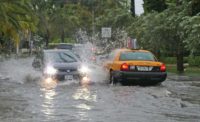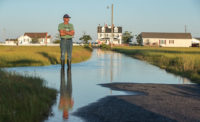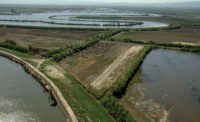In one respect, Tangier Island, Va.’s situation has been the same for centuries: Its shorelines are still eroding into the Chesapeake Bay. Since 1850, its land mass has dropped by two-thirds, now measuring roughly 1.2 sq miles, according to U.S. Army Corps of Engineers estimates.
 But the Corps has concerns beyond erosion. With a maximum elevation of roughly 4 ft, even slight rises in sea level could threaten the community of 460 residents. Recent modeling by the Corps suggests Tangier could be uninhabitable within 25 to 50 years.
But the Corps has concerns beyond erosion. With a maximum elevation of roughly 4 ft, even slight rises in sea level could threaten the community of 460 residents. Recent modeling by the Corps suggests Tangier could be uninhabitable within 25 to 50 years.
James Eskridge, mayor of Tangier Island, says he and many of the island’s residents see an immediate need to address erosion, which annually can eat up 25 ft of the island’s unprotected shorelines. Today, those shorelines are fast approaching the town itself. “There’s a lot of talk about sea-level rise, but this erosion problem you can see almost weekly,” Eskridge says.
To date, efforts to reduce erosion have been successful. Installed in 1989 on the west side of the island close by the harbor, a nearly one-mile-long seawall halted shoreline retreat and saved the island’s airport and wastewater treatment plant. Meanwhile, unprotected shoreline on the other side of the western harbor entrance has eroded by hundreds of feet, leaving boats, crab shanties and harbor infrastructure more vulnerable. Next year, the Corps plans to build a $3.6-million, 500-ft jetty to reduce the opening of the harbor to its previous width.
Erosion threatens nearly all of Tangier, so a segmented breakwater system has been proposed. The plan includes a series of dunes, which could be built behind the breakwater system.
The town of Tangier is built on a series of ridges, so a Corps proposal suggests using dredging sand to restore these ridges to between 6.6 ft and 9.8 ft above 2013 high-tide levels.
Estimated to cost between $20 million and $30 million, the breakwater and restoration plan does not have funding and has not been approved to move ahead.
While Tangier welcomes any help, Eskridge maintains that its residents need solutions to erosion issues now. “The sea-level rise that’s being discussed, I put it like this: If you have an illness that’s going to kill you in 40 years but you have a heart blockage right now and you have chest pains, you need to deal with the chest pains right now,” he says. “Deal with the other later.”





Post a comment to this article
Report Abusive Comment